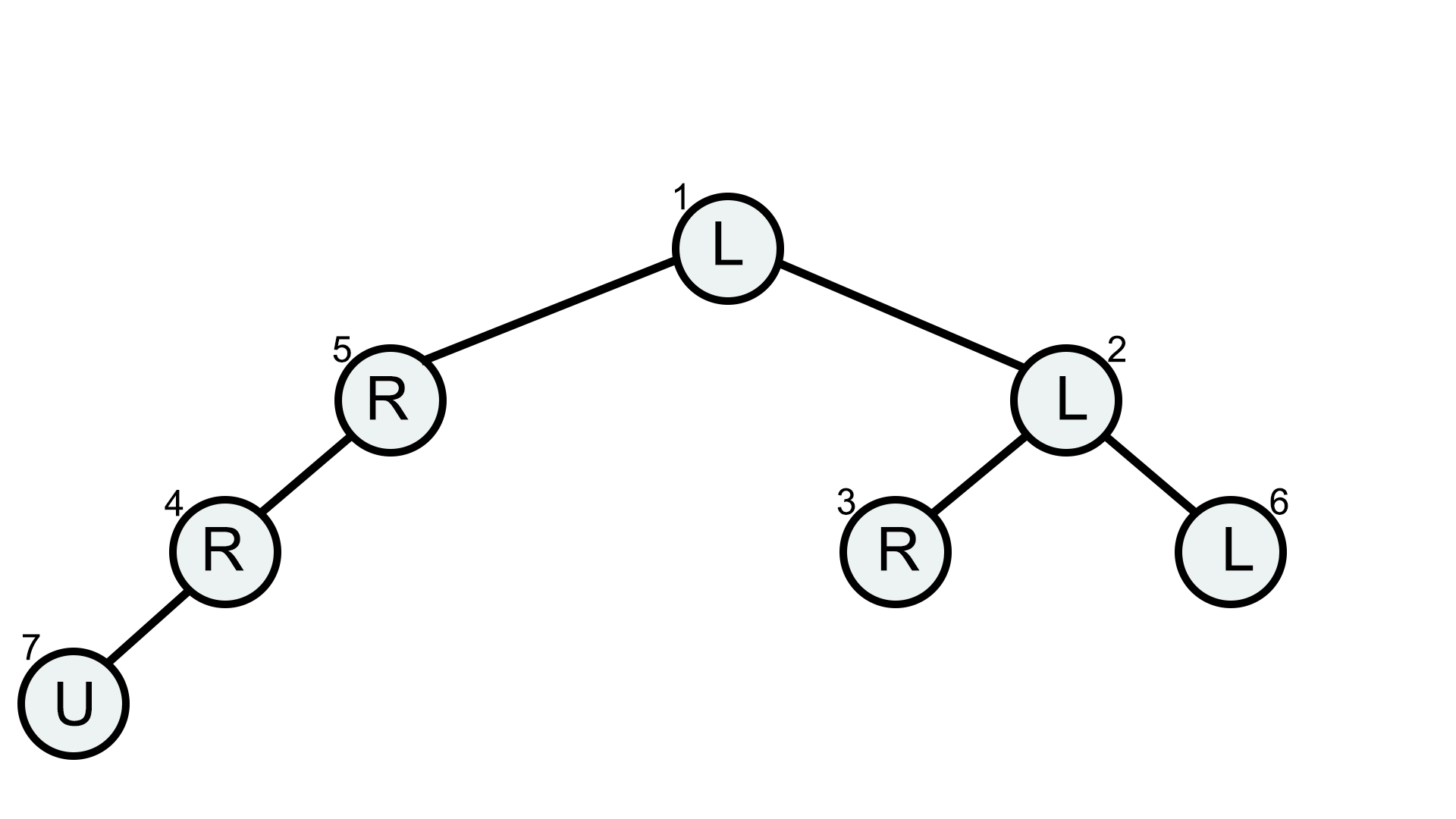310856: CF1900C. Anji's Binary Tree
Description
Keksic keeps getting left on seen by Anji. Through a mutual friend, he's figured out that Anji really likes binary trees and decided to solve her problem in order to get her attention.
Anji has given Keksic a binary tree with $n$ vertices. Vertex $1$ is the root and does not have a parent. All other vertices have exactly one parent. Each vertex can have up to $2$ children, a left child, and a right child. For each vertex, Anji tells Keksic index of both its left and its right child or tells him that they do not exist.
Additionally, each of the vertices has a letter $s_i$ on it, which is either 'U', 'L' or 'R'.
Keksic begins his journey on the root, and in each move he does the following:
- If the letter on his current vertex is 'U', he moves to its parent. If it doesn't exist, he does nothing.
- If the letter on his current vertex is 'L', he moves to its left child. If it doesn't exist, he does nothing.
- If the letter on his current vertex is 'R', he moves to its right child. If it doesn't exist, he does nothing.
You are interested in the minimal number of operations he needs to do before his journey, such that when he starts his journey, he will reach a leaf at some point. A leaf is a vertex that has no children. It does not matter which leaf he reaches. Note that it does not matter whether he will stay in the leaf, he just needs to move to it. Additionally, note that it does not matter how many times he needs to move before reaching a leaf.
Help Keksic solve Anji's tree so that he can win her heart, and make her come to Čačak.
InputEach test consists of multiple test cases. The first line contains a single integer $t$ ($1 \le t \le 5 \cdot 10^4$) — the number of test cases. The description of test cases follows.
The first line of each test case contains a single integer $n$ ($2 \le n \le 3 \cdot 10^5$) — the number of vertices in a tree.
The second line of each test case contains a string $s$ of $n$ characters — characters are written on the vertices. It is guaranteed that $s$ consists only of characters 'U', 'L', and 'R'.
The $i$-th of the next $n$ lines contains two integers $l_i$ and $r_i$ ($0 \le l_i, r_i \le n$) — indices of left and right child of the vertex $i$. If $l_i = 0$, it means that vertex $i$ does not have a left child. If $r_i = 0$, it means that vertex $i$ does not have a right child. It is guaranteed that this data describes a valid binary tree rooted at $1$.
It is guaranteed that the sum of $n$ over all test cases does not exceed $3 \cdot 10^5$.
OutputFor each test case, output a single integer — the minimal number of operations Keksic needs to do to reach a leaf.
ExampleInput5 3 LRU 2 3 0 0 0 0 3 ULR 3 2 0 0 0 0 2 LU 0 2 0 0 4 RULR 3 0 0 0 0 4 2 0 7 LLRRRLU 5 2 3 6 0 0 7 0 4 0 0 0 0 0Output
0 1 1 3 1Note
In the first test case, vertex $1$ has $2$ as its left child and $3$ as its right child. Vertices $2$ and $3$ do not have children and are therefore leaves. As 'L' is written on vertex $1$, Keksic will go to vertex $2$, therefore he has to do no operations.
In the second test case, vertex $1$ has $3$ as its left child and $2$ as its right child. Vertices $2$ and $3$ are leaves. As 'U' is written on vertex $1$, Keksic needs to change it to either 'L' or 'R' in order for him to reach a leaf.
In the third case, vertex $1$ has only a right child, which is vertex $2$. As 'L' is written on it, Keksic needs to change it to 'R', otherwise he would be stuck on vertex $1$.
In the fourth case, he can change $3$ characters so that letters on the vertices are "LURL", which makes him reach vertex $2$.
In the fifth case, there are $3$ leaves, $3$, $6$ and $7$. To reach either leaf $6$ or leaf $7$, he needs to change $2$ characters. However, if he changes character on vertex $1$ to 'R', he will reach leaf $3$, therefore the answer is $1$.
 The initial tree in test case 5.
The initial tree in test case 5.
Output
一个二叉树上有n个顶点,顶点1是根节点,每个顶点有一个字母's_i',值为'U','L'或'R'。从根节点开始,根据当前顶点的字母移动,'U'则移动到父节点,'L'则移动到左孩子,'R'则移动到右孩子。现在可以修改任意顶点的字母,求最小修改次数,使得能从一个顶点移动到叶子节点。
输入数据格式:
第一行:一个整数t,表示测试用例数量。
每个测试用例:
第一行:一个整数n,表示顶点数量。
第二行:一个长度为n的字符串,表示每个顶点的字母。
接下来n行,每行两个整数l_i和r_i,表示第i个顶点的左右孩子,0表示没有孩子。
输出数据格式:
每个测试用例输出一个整数,表示最小修改次数。题目大意: 一个二叉树上有n个顶点,顶点1是根节点,每个顶点有一个字母's_i',值为'U','L'或'R'。从根节点开始,根据当前顶点的字母移动,'U'则移动到父节点,'L'则移动到左孩子,'R'则移动到右孩子。现在可以修改任意顶点的字母,求最小修改次数,使得能从一个顶点移动到叶子节点。 输入数据格式: 第一行:一个整数t,表示测试用例数量。 每个测试用例: 第一行:一个整数n,表示顶点数量。 第二行:一个长度为n的字符串,表示每个顶点的字母。 接下来n行,每行两个整数l_i和r_i,表示第i个顶点的左右孩子,0表示没有孩子。 输出数据格式: 每个测试用例输出一个整数,表示最小修改次数。